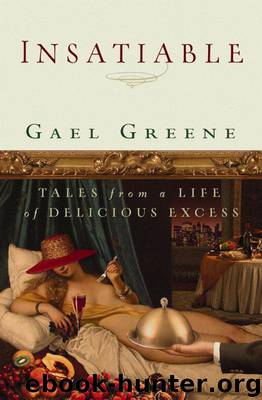Insatiable by Gael Greene

Author:Gael Greene
Language: eng
Format: mobi, epub
ISBN: 9780759515338
Publisher: Grand Central Publishing
Published: 0101-01-01T00:00:00+00:00
Impressionable grape nuts of the seventies, on easy sipping terms with French wines, were eager to know more. What did New Yorkers see in zinfandel? Well, for one thing, they could pronounce it. Now with wine authority Gerald Asher beating the drum, the great California winemakers flew in for the Four Seasons’ first Barrel Tasting in 1976. Soon Chardonnays and cabernets from what wine writer Anthony Dias Blue called “the auteur school of wine-making,” would be whipsawing the French by winning much-publicized competitive blind tastings in Paris.
The French were not discouraged. In May of 1976, Regine opened a flashy mirrored boîte on Park Avenue, with Michel Guérard coaching the kitchen. Purists were aghast at the tackiness of linking great food and disco. But it made sense to me. We could eat Guérard’s astonishing egg (caviar) and egg (scrambled) in an eggshell and dance it off till 4:00 AM. And wasn’t it ecumenical of Regine to put two American kitchen acolytes to work: Larry Forgione, a graduate of the Culinary Institute of America, and Patrick Clark, just out of NYC Technical College.
An aristocratic expatriate, Marina de Brantes, designed the Coup de Fusil on East Sixty-fourth Street* with the chef Yannick Kam. It was dedicated to the nouvelle gospel. Nouvelle cuisine was wildly contagious. Soon impressionable eaters were caught in a quicksand of purees. Plates got bigger; portions got smaller. What was raw got cooked; what had been cooked was now raw. Vegetables were laid out as if they were precious jewels, a carrot, a brussels sprout, a turnip carved into a baton. Dinner was a still life on a plate.
Fresh-turned pasta was a fetish of the seventies. We early foodies made our own fettuccine at home, but then the first Pasta & Cheese shop opened in 1976 and cloned itself in the neighborhoods. French chefs had looked down their noses at the cooks of Italy for generations, but soon they had all borrowed ravioli. Anything could be stuffed into ravioli—goat cheese, ratatouille, even garlic puree. Sirio Maccioni, passionately Italian at Le Cirque—what he disarmingly called his “French bistro”—got his congregation to eat pasta primavera, except for the calorie counters and X rays who lived on chopped salad.
Restaurant Associates’ exiled wizard Joe Baum’s magnum opus atop the much-reviled World Trade Center, Windows on the World, had the city looking up in the recessionary spring of 1976. I spent two weeks watching Baum worrying the details and was wowed by what he and his architect had wrought on the 107th floor of the north tower. “If money and power and ego and a passion for perfection could create this extraordinary pleasure, this instant landmark . . . money and power and ego could rescue the city from its ashes,” I wrote. It was the most optimistic moment in architecture since the Rockefellers gave us Rockefeller Center at the height of the Depression. To make the point, the magazine’s cover showed just the restaurant, as if suspended in the air, minus the tower beneath.
Download
This site does not store any files on its server. We only index and link to content provided by other sites. Please contact the content providers to delete copyright contents if any and email us, we'll remove relevant links or contents immediately.
A Court of Wings and Ruin by Sarah J. Maas(7265)
The Sprouting Book by Ann Wigmore(3409)
Better Homes and Gardens New Cookbook by Better Homes & Gardens(3371)
The Death of the Heart by Elizabeth Bowen(3342)
BraveTart by Stella Parks(3307)
Salt, Fat, Acid, Heat: Mastering the Elements of Good Cooking by Nosrat Samin(2998)
Sauces by James Peterson(2964)
The Bread Bible by Rose Levy Beranbaum(2887)
Classic by Mary Berry(2835)
Kitchen confidential by Anthony Bourdain(2831)
Solo Food by Janneke Vreugdenhil(2823)
Ottolenghi - The Cookbook by Yotam Ottolenghi(2738)
Martha Stewart's Baking Handbook by Martha Stewart(2676)
Betty Crocker's Good and Easy Cook Book by Betty Crocker(2598)
Day by Elie Wiesel(2593)
My Pantry by Alice Waters(2434)
The Plant Paradox by Dr. Steven R. Gundry M.D(2427)
The Kitchen Counter Cooking School by Kathleen Flinn(2396)
Hot Sauce Nation by Denver Nicks(2369)
